Super User
GCF validates IMS test cases from Rohde & Schwarz for 5G NR protocol conformance
In cooperation with MediaTek, Rohde & Schwarz has submitted test cases for 5G NR protocol conformance test to the Global Certification Forum (GCF). The test cases have been validated successfully, adding on to the company’s legacy in IP Multimedia Subsystem (IMS) protocol conformance testing.
The Global Certification Forum has validated successfully IMS conformance test cases for 5G NR submitted by Rohde & Schwarz, using a 5G device under test from mobile platform provider MediaTek (MTK). Consequently, the test cases can now be used for certification testing according to the GCF. This achievement comes only a few weeks after the validation of the IMS test cases by the PTCRB.
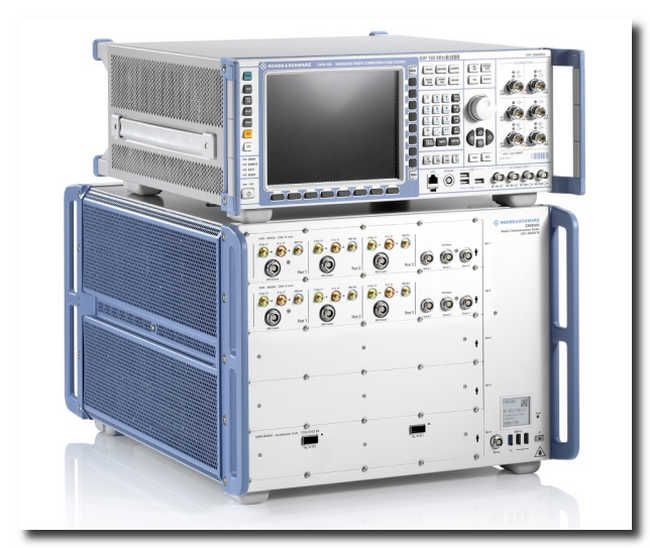 Validated 5G IMS test cases from Rohde & Schwarz (Image: Rohde & Schwarz)
Validated 5G IMS test cases from Rohde & Schwarz (Image: Rohde & Schwarz)
To make sure cellular devices work in different mobile networks properly, they need to be certified by test labs which are accredited by either GCF or PTCRB. This step is mandatory, before mobile devices are accepted by network operators. Part of this certification are tests for IP Multimedia Subsystem.
Rohde & Schwarz has maintained a leading position in LTE conformance and operator acceptance testing, as well as in 5G IMS testing for operators. The Rohde & Schwarz solution for conformance testing is based on the trusted R&S CMW500 protocol conformance tester. In connection with the R&S CMX500 radio communication tester, all test systems can be upgraded for 5G NR. Software option R&S CMX-KC621X adds the validated 5G IMS test cases on the R&S CMX500.
For more information on the Rohde & Schwarz range of wireless testing solutions, visit: http://rohde-schwarz.com/wireless
Rohde & Schwarz
Rohde & Schwarz is a leading supplier of solutions in the fields of test and measurement, broadcast and media, aerospace | defense | security and networks and cybersecurity. The technology group's innovative communications, information and security products help industry and government customers ensure a safer and connected world. On June 30, 2020, Rohde & Schwarz had about 12,300 employees worldwide. The independent group achieved a net revenue of EUR 2.58 billion in the 2019/2020 fiscal year (July to June). The company is headquartered in Munich, Germany, and has subsidiaries in more than 70 countries, with regional hubs in Asia and America.
R&S® is a registered trademark of Rohde & Schwarz GmbH & Co. KG.
SIPCHEM Demonstrates Commitment and Sustainable Progression to Quality with Q-Pulse
Leading global provider of software products to companies operating in highly regulated industries, Ideagen Plc, has announced that Sahara International Petrochemical Company (Sipchem) has become the latest customer of its industry-leading quality management software Q-Pulse.
Based in Saudi Arabia, Sahara International Petrochemical Company (Sipchem) is one of the world's leading petrochemical companies with more than 22 years of operating history, market presence in more than 80 countries and total assets of SAR 23.8 bn. Sipchem was stablished in 1999, became a publicly listed company in 2006 and was included in the MSCI Emerging Markets Index in 2019. Sipchem was also recognized for creating the "Best Work Environment" in the Kingdom of Saudi Arabia and was awarded the “King Khalid Sustainability Award 2019”.
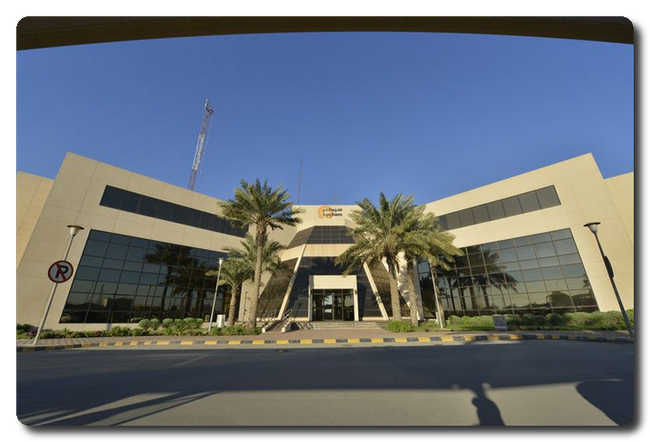
Ibrahim Al Rushoud; VP Manufacturing at Sipchem, said: "Sipchem's success has been built on our ability to produce quality petrochemicals while at the same time maintaining a strong commitment to upholding the highest safety and environmental standards. Using Q-Pulse will give us an unrivalled oversight of our processes and procedures and allow us to operate to an even higher standard."
Q-Pulse allows organizations to have complete oversight of every aspect of their business using data intelligence and insights, quick data-driven decision making to exploit opportunities, and the ability to create an automated digital culture where quality and compliance is embedded throughout the organization.
Joe Moore, Sales Consultant at Ideagen, said: "Q-Pulse will support Sipchem to achieve the standardization of quality controls and processes across the business that they are looking for. The product is intuitive and easy to use, which will make the company's efforts to embed a culture of quality across the organization much more effective."
For more information contact:
Heather Astbury, This email address is being protected from spambots. You need JavaScript enabled to view it.
About Ideagen plc
Ideagen is a UK-headquartered, global technology company quoted on the London Stock Exchange AIM market (Ticker: IDEA.L).
A global supplier of regulatory and compliance solutions, Ideagen provides a common software platform and an integrated risk- based approach to meet multi-industry standards, enabling compliance with relevant laws, policies, and regulations.
The Group provides software and services to organisations operating within highly regulated industries such as life sciences, healthcare, banking and finance, insurance, aviation, and aerospace and defence, with its main operational premises spread throughout the UK, EU, US, Middle East and SE Asia.
Currently, more than 6,000 organisations use Ideagen's products including seven of the top 10 UK accounting firms, all of the top aerospace and defence companies and 75% of the world's leading pharmaceutical firms. Ideagen's diverse and varied customer base includes many well-known, global brands such as British Airways, Aggreko, BAE, Ryanair, US Navy, KLM, BBVA, Bank of New York, Commerzbank, Meggitt, Heineken, Johnson Matthey, Haeco Group and European Central Bank. As well as this, Ideagen counts 250 hospitals across the UK and US amongst its client base.
For further information please visit www.ideagen.com
Port of Malta - Nidec ASI is awarded a €12 million contract for the electrification of the berths
Nidec ASI is awarded a €12 million contract for the electrification of the berths in the port of Malta, which will relaunch tourism from a more sustainable perspective
This innovative electrical supply system for cruise ships moored in the port will reduce emissions by over 40 tons a year and lower noise pollution, a benefit to both tourists and the local community
Nidec ASI—head of the Nidec Industrial Solutions platform belonging to the Nidec Group, one of the groups engaged in restarting the economy with a view to greater sustainability—has signed a €12 million contract with the Maltese company Excel Sis for the creation of a “shore-to-ship” project for the port of La Valletta (Malta). The project will make it possible for cruise ships moored at the five berths to draw from the island’s energy grid the power they require to be fully operative, without having to keep their polluting on-board diesel engines running. This innovative system will make it possible to reduce the emissions of pollutant gases by over 40 tons a year, the equivalent of continuous circulation of over 4 million vehicles, and will contribute to creating the basis for a more eco-friendly and innovative relaunching of tourism, a key sector in the Maltese economy.
The project complies with the necessity of following European Union directives which encourage ports to adopt berth electrification systems (shore-to-ship) to reduce polluting emissions of vessels in the port, while maintaining active heating and air conditioning, as well as vessel auxiliary systems. By 2025, this recommendation will become binding for all European ports and it has also been included in the EU Recovery Plan which places reducing environmental impact among the priorities in relaunching European countries. Within this context, Malta and its main port of La Valletta provide an example for all European (and other) ports to follow. The entire project was planned from the very earliest feasibility studies and will be coordinated through to its completion by Infrastructure Malta (IM), the Maltese government agency responsible for all the country’s infrastructure projects.
Nidec ASI, which together with the main contractor Excel Sis received the highest technical and economic rating in the call for bids, has been involved for years in the spread of these technologies to provide a 100%-electric future for both naval and other forms of transport, as well as logistics. In fact, it is currently completing the electrification of the berths in Genoa’s Port of Prà, after also having installed its systems in the ports of Leghorn, the Muggiano (La Spezia) shipyards, EDISON–Navalimpianti - FSO Alba Marina and a number of other ports. The company was one of the first players in the world to promote berth electrification, a solution that provides for a significant reduction in the impact of port activities on the environment and on people to promote a drastic reduction in the emission of pollutant gases and noise from berthed vessels.
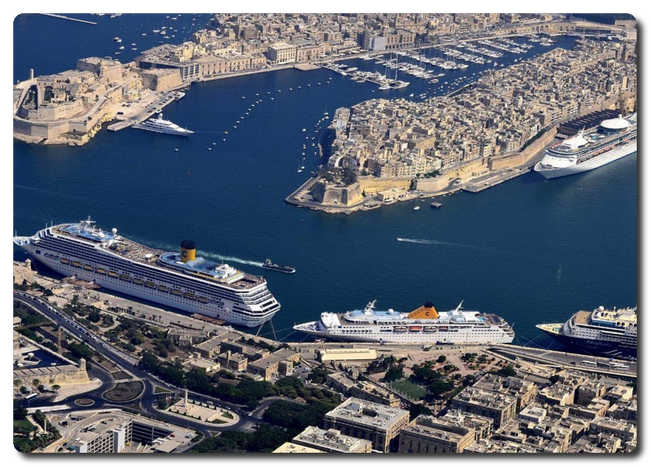
In fact, thanks to the contribution of Nidec ASI technologies, the port of Malta will be able to reduce SOx, NOx, CO2 and PM emissions which are a significant source of pollution for the tourist-oriented Isle of Malta. In addition, by plugging ships into the national grid, and thereby avoiding the use of on-board diesel generators, the noise pollution so annoying for tourists and local residents is also greatly reduced.
Specifically, Nidec ASI was awarded the supply of power and high-tech systems and all related engineering, including transformers, converters and the cable management system. Its extensive practical experience allowed the company to develop and implement this complex project. In fact, the unique nature of every cruise ship required the development of a specific solution for each to be able to connect the vessel with the energy grid, and Nidec ASI chose a cable management system capable of meeting the needs of the different ships.
“We are truly proud that our partner and main contractor Excel Sis and Infrastructure Malta have chosen our proven expertise in project management and our custom solutions for this key project which, for us, represents a new objective in our strategy to promote sustainable development and reduce environmental impact in transport and logistics, towards an all-electric future. The transformation of logistics and port infrastructure from the standpoint of greater security and energy savings can also contribute to attracting a greater flow of tourists who are increasingly concerned about respect for the environment. This will aid in relaunching the tourism and business sectors which have been particularly hit by the effects of the pandemic,” said Dominique Llonch, CEO of Nidec ASI and Chairman of Nidec Industrial Solutions. “Thanks to our expertise in the areas of automation and battery storage systems, we are able to electrify the entire port, from cranes to internal transport by using charging stations installed in microgrids within the port area. Times such as these are ideal for promoting infrastructural transformation which is also made easier by lower traffic levels. Our hope is that the example of Malta—and that of other earlier ports such as Genoa Prà—will be followed soon by many others in Italy and Europe to comply with EU norms and to make the best use of the funds allocated in the Recovery Plan to, finally, act from a sustainable and green standpoint.”
This new project, together with other shore-to-ship systems implemented in Italy and France and other major initiatives such as the supply of storage battery systems for onboard energy for full-electric and hybrid cargo ships, ferries and yachts (with the possibility of providing automatic fast-recharging from land), and solutions for automating cranes used in ports, make Nidec ASI a true leader in the evolution of the maritime and port sector towards all-electric, so key to navigation and logistics that are increasingly green and sustainable. The group is also fully-active in the transport sector through promoting the development of electric cars utilizing an ultra-fast recharging system for e-vehicles. For over 40 years, it has also been creating ropeway systems with the goal of making them an increasingly-utilized system of public transport, while also supplying systems for recharging electric buses and passenger transport via tram/trolley.
US Climate Envoy Kerry resets climate relations before Glasgow summit
The United States government is renewing efforts to combat the climate crisis, amid fears of irreversible disaster if sufficient action is not taken.
Following the previous administration’s withdrawal from the 2016 Paris Agreement, Washington aims to show greater climate-awareness, notably by re-joining the agreement.
This has bolstered European Union hopes of improving US relations, after four years of climate hostility between the former Trump administration in Washington and its Brussels counterparts.
US Climate Envoy John Kerry has even implied that the Paris treaty might not go far enough, explaining that global warming would continue even if everybody applied the terms of the agreement, a point to be addressed by a US-hosted meeting of nations in April to raise ambitions ahead of the November UN climate summit in Glasgow, Scotland.
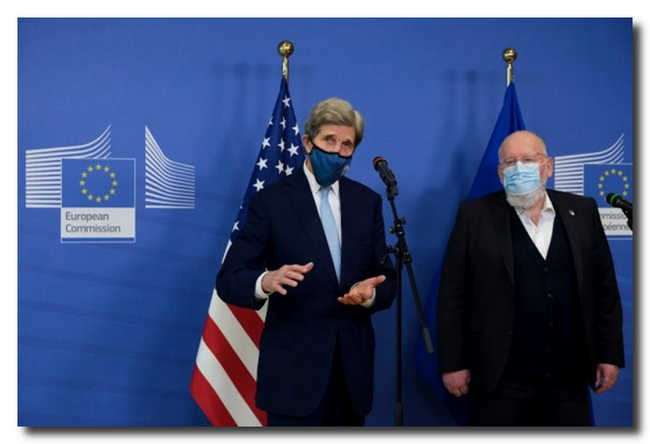 EU Commission Vice-president in charge for European Green Deal Frans Timmermans and US Special Presidential Envoy for Climate John Kerry, Brussels, Belgium on March 9th, 2021.
EU Commission Vice-president in charge for European Green Deal Frans Timmermans and US Special Presidential Envoy for Climate John Kerry, Brussels, Belgium on March 9th, 2021.
"This is the moment for countries, common sense, people, to come together and get the job done," said Kerry, adding: "This decade 2020 to 2030 must be the decade of action.”
European Commission president Ursula von der Leyen was delighted to find an ally in the United States once again: "It's wonderful to have a good friend back in the EU and it is wonderful to know that we have a friend again in the White House," she said of Kerry.
Both the US and EU are banking on new technologies and innovation to help cut urban emissions, where nearly 75% of global primary energy supply is consumed. Understanding patterns here may help to address challenges to sustainability and energy security.
However, urban energy analyses are severely limited by lack of data. It is virtually non-existent in developing countries yet current projections suggest that new urban growth is bound to occur in these data-starved regions.
A solution to the issue of low levels of data aggregation and analyses in urban areas is Cityzenith’s newly released SmartWorldOS Digital Twin technology, which can aggregate, integrate, analyze, and visualize all urban development and infrastructure and manage climate-friendly low emission actions and projects.
Earlier SmartWorld versions have been involved in the planning for the new Orlando Sports and Entertainment District, home of the Orlando Magic basketball team, the $6.5 billion greenfield smart regional capital city of Amaravati, India, as well as many other urban development projects around the world.
And Cityzenith CEO Michael Jansen backed the US Climate Envoy’s message: “This significant repositioning by the US underlines that we have reached a tipping point in the march towards fossil fuel independence. The world's cities produce 70+% of all the world's carbon emissions and must be ground zero for the climate resilience battle, creating a new market for cutting edge decarbonization technologies that perhaps many of us never thought possible.
“The most essential of all of those technologies is Digital Twins. A recent study predicted that by 2025, 500 major world cities will rely on Digital Twin technology to integrate and optimize a multitude of common city functions. I believe this trend will be driven principally by the need to reconfigure cities everywhere as a platform to support and catalyze the development of local, liveable zero-carbon economies as nations tackle climate change.
“And this is why Cityzenith launched its ‘Clean Cities - Clean Future’ initiative late last year, pledging to donate its SmartWorldPro Digital Twin software to 10 major cities dedicated to addressing Climate Change - we will announce the first project in the next few months.”
About Cityzenith
Cityzenith is based in Chicago with offices in London and New Delhi. The company's SmartWorldPro2™ Digital Twin platform was created for anyone designing, constructing, and managing complex, large-scale building projects, properties, and real estate portfolios. Find out more at www.cityzenith.com
Moxa Demonstrates Its Commitment to Securing Industrial Networks By Becoming IEC 62443-4-1 Certified
Moxa Inc., a leader in industrial communications and networking, with a focus on securing industrial networks, is delighted to announce it has obtained the IEC 62443-4-1 certification pertaining to cybersecurity standards. The certification testing and audit was performed by LCIE Bureau Veritas and issued by the IECEE certification body. Moxa has always been involved in the cybersecurity industry and was one of the first companies globally to become IEC 62443-4-1 certified by the world-leading conformity assessment and certification services provider.
The IEC 62443 standard Part 4-1 defines a secure development lifecycle for the purpose of developing and maintaining secure products used in industrial automation and control systems. The IEC 62443-4-1 certificate confirms that Moxa has implemented a secure by design methodology from the first day of the product development process, which includes complete security lifecycle management and patch management. This certificate also demonstrates Moxa’s capability to identify and respond to vulnerabilities and work with customers to mitigate their risks.
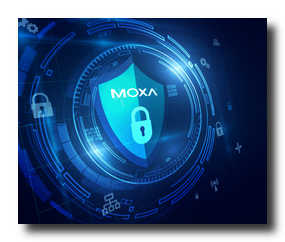 According to IDC’s latest worldwide IT and OT Convergence survey in 2020, the key motivations for IT/OT convergence are enhancing operational safety and performance, reducing costs, and improving quality. Another important observation from the report is that globally, 48.8% of IT and OT management owners consider security to be the top barrier to IT/OT convergence. This point highlights the importance OT enterprises place on security when embracing Industry 4.0 or the Industrial Internet of Things (IIoT) in order to significantly enhance operational efficiency and productivity.
According to IDC’s latest worldwide IT and OT Convergence survey in 2020, the key motivations for IT/OT convergence are enhancing operational safety and performance, reducing costs, and improving quality. Another important observation from the report is that globally, 48.8% of IT and OT management owners consider security to be the top barrier to IT/OT convergence. This point highlights the importance OT enterprises place on security when embracing Industry 4.0 or the Industrial Internet of Things (IIoT) in order to significantly enhance operational efficiency and productivity.
“In response to our customer’s concerns, Moxa has been actively looking into the security requirements of IEC 62443 standards dating back to when they were still under development in 2016,” said Samuel Chiu, General Manager of Moxa Networking Co. Ltd. “By adhering to the strict verification process of IEC 62443 standards, Moxa not only provides industrial-grade solutions, but also ensures that security is part of the DNA of its reliable networking solutions throughout the product development process. We provide our customers with the assurance that they can connect their valuable assets with Moxa’s solutions and be confident that they can keep their operations running smoothly.”
Moxa has also been following the evolving cybersecurity best practices in order to ensure our solutions work harmoniously with the latest technological innovations of edge devices while mitigating the latest cyberthreats. One of the best practices is shared in Enhancing ICS Cybersecurity in the Software Development Lifecycle. This article, which features on the ISA Global Cybersecurity Alliance blog, was contributed to by SZ Lin, Assistant Project Manager at the Technology and Research Corporate Division of Moxa. Lin was the first person in Taiwan to be awarded the ISA/IEC 62443 Cybersecurity Expert Certificate. In addition to Lin, Felipe Sabino Costa, whose current roles include ISA cybersecurity instructor and Moxa LATAM Industrial Cybersecurity Expert, also pointed out some key criteria in his article Can a Solution Provider Handle Industrial Cybersecurity? 8 Questions to Ask. His article can also be found on the ISA Global Cybersecurity Alliance blog, and has helped guide business owners to develop mission-critical solutions that include cybersecurity by design.
Before obtaining the IEC 62443-4-1 certificate in May 2020, Moxa has been following the development of the standard for five years and has designed our products in accordance with its guidelines. In addition, Moxa has spent considerable resources on educating the market about not only the importance of the standard, but how we embed its principles throughout all stages of our hardware and software development. Only when cybersecurity awareness is increased can industrial network security be enhanced by joint forces. Bearing this in mind, Moxa will continue investing in cybersecurity and work closely with our customers to ensure that “secure by design” solutions can be implemented successfully.
About Moxa
Moxa is a leader in edge connectivity, industrial computing, and network infrastructure solutions for enabling connectivity for the Industrial Internet of Things. With over 30 years of industry experience, Moxa has connected more than 71 million devices worldwide and has a distribution and service network to serve customers in more than 80 countries.
HBK strain gauges measure vibration of new piledriving method for offshore wind turbines
New piledriving method limits noise reduction by 90% to 95% and simplifies logistics
Dutch installation specialist, GBM Works is developing a new method to reduce the noise pollution caused by driving foundation piles for wind turbines into the seabed.
This method involves fluidising the seabed with water jets, which ensures the monopiles sink much quicker - and with significantly less noise - under their own weight. To assess this new system at the Maasvlakte site, tests were carried out to measure the monopiles’ vibrations and deformations using strain gauges, supplied by HBK.
Ben Arntz, founder and director of GBM Works explains: “Driving foundation piles for wind turbines into the seabed causes vibrations, pressure waves and - in particular - also a great deal of noise. When a steel foundation pile with a diameter of eight metres is driven, the noise production can reach a level up to 180 decibels. The vibrations, the pressure waves and the loud noise have a negative effect on underwater life. Therefore regulations have been adopted to reduce the noise production of piledriving activities at sea. International guidelines are expected to become stricter in the coming years. Our new method responds to this.”
Mr. Arntz continues: “On the inside of the pile, dozens of water jets spray seawater into the seabed. As a result, the seabed takes on properties comparable to those of quicksand. The resistance of the seabed decreases and the foundation pile sinks into the seabed. The second part of the solution is a vibratory hammer that replaces the hydraulic piledriving rig. In a traditional piledriving rig, a steel pile hammer strikes a foundation, made from the same material, which produces a great deal of noise. The vibratory hammer consists of rotating disks mounted on top of the monopile. These cause the monopile to vibrate so that it sinks into the fluidised seabed layer.”
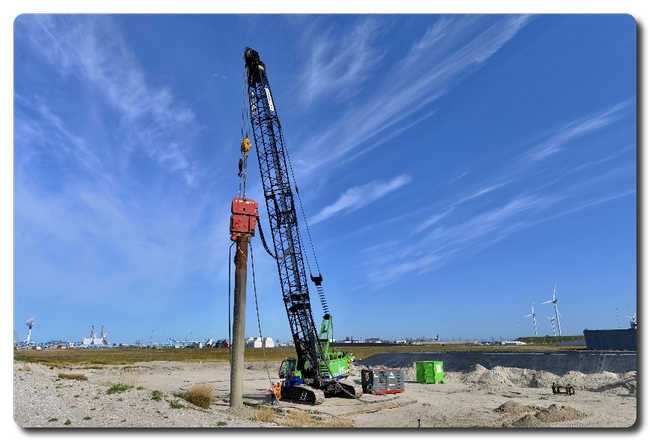 Test site at the Maasvlakte
Test site at the Maasvlakte
To assess the operation of the system and demonstrate the added value of the new method in practice, a series of tests was conducted at the Maasvlakte in September 2020. “The aim was, among other things, to collect information on the vibrations that arise, the water pressure that is needed, the behaviour of the soil and - of course - the effect on noise damping. In all, 62 test installations were executed with four setups: two with the jet gun system and the vibratory hammer, and two tests with the vibratory hammer alone on the same foundation piles. To measure the strain in the monopiles GBM Works chose to use strain gauges from HBK. These strain gauges are often used to monitor wind turbines. When you exert pressure on steel monopiles, deformation occurs, and vibrations arise that cause noise. We measured those vibrations and also got some interesting information on fatigue in the foundation piles.’’
“Most of the data now has been analysed,” said Wouter Verschueren, Data & Model engineer at GBM Works. “We saw, for example, that the foundation piles with the vibratory hammer alone penetrated the ground no farther than three or four metres because the soil resistance became too high. With the jet gun and the vibratory hammer, the piles easily went to a depth of 10 metres, while the speed at constant force quadrupled. In a subsequent test cycle underwater the noise production of the solution with the vibratory hammer and the jet gun will be compared to that of a traditional pile hammer. A piledriving rig in combination with a sound mitigation system is currently used. These are complex systems that operate with an underwater shield around the foundation pile to damp the vibrations and noise. GBM Works expects a noise reduction of 90 to 95 percent thanks to the new system.”
It was recently announced that GBM Works will be granted a subsidy of 1,8 million Euro by RVO for the development of a prototype of the equipment.
About HBK – Hottinger Brüel & Kjær
Industry market leaders HBM and Brüel & Kjær have joined forces as HBK - Hottinger, Brüel & Kjaer to form the world’s foremost provider of integrated test, measurement, control and simulation solutions.
HBK – Hottinger, Brüel & Kjaer provides a complete portfolio of solutions across the test and measurement product life cycle, that unites the physical world of sensors, testing and measurement with the digital world of simulation, modelling software and analysis. By creating a scalable and open data acquisition hardware, software and simulation ecosystem, product developers can cut time-to-market, drive innovation and take the lead in a highly competitive global marketplace.
For more information visit www.hbkworld.com
Load cells take the strain for fine-food specialist
Cheesemaker specialist, Fruitières Chabert has optimised its assembly and packaging lines with an innovative load sensor system, that enables faster production without compromising hygiene standards.
 Located at Annecy-le-Vieux fruit farm, this family run company is constantly innovating and looking for new technologies to optimize each stage of cheese production, such as sorting and weighing. The aim is to comply with the strict PDO specifications (Protected Designation of Origin) for cheese which is distinguished by a number of quality labels.
Located at Annecy-le-Vieux fruit farm, this family run company is constantly innovating and looking for new technologies to optimize each stage of cheese production, such as sorting and weighing. The aim is to comply with the strict PDO specifications (Protected Designation of Origin) for cheese which is distinguished by a number of quality labels.
France’s controlled designation of origin (Appellation d’Origine Contrôlée) also imposes rigorous requirements, so Fruitières Chabert’s technology suppliers had to be able to authenticate all the certification necessary for national and international export of its products, while preserving local know-how, respectful of Savoyard traditions.
As a result, the Chabert company, approached Fine-Spect, a company that not only specializes in dynamic sorting, calibration and weighing, but also has experience making machines for the agri-food industry. After assessing Fruitières Chabert’s needs, Fine-Spect created a specialist checkweigher, which contains a digital FIT7A load cell, provided by HBM. This load cell is based on the strain gauge principle and offers unrivalled performance in the field of dynamic weighing for the food industry.
Fine-Spect chose this particular load cell as it met all the required market specifications such as pure metrological level performance, long term robustness and reliability, corrosion resistance and compatibility with industry-standard communication protocols.
Mr Favre, Industrial Director of the Chabert cheese dairy says: “This installation will sometimes be subject to extreme conditions of use, for example, dismantling and daily cleaning using high pressure steam according to food industry standards. It is therefore essential that the equipment is robust and, at the same time, of the highest standard so that our technicians have no problem-solving problems quickly. The work carried out by Fine-Spect using HBM’s FIT7A transducers is a source of efficiency and success.”
The full case study is available here: https://www.hbm.com/en/10131/dynamic-weighing-with-fit7-and-the-iconic-reblochon/
About HBK – Hottinger Brüel & Kjær
Industry market leaders HBM and Brüel & Kjær have joined forces as HBK - Hottinger, Brüel & Kjaer to form the world’s foremost provider of integrated test, measurement, control and simulation solutions.
HBK – Hottinger, Brüel & Kjaer provides a complete portfolio of solutions across the test and measurement product life cycle, that unites the physical world of sensors, testing and measurement with the digital world of simulation, modelling software and analysis. By creating a scalable and open data acquisition hardware, software and simulation ecosystem, product developers can cut time-to-market, drive innovation and take the lead in a highly competitive global marketplace.
For more information visit www.hbkworld.com
TSC Printronix Auto ID announces biggest ever overhaul of its best-selling industrial printers and print engines
New models and advances in security, wireless connectivity, remote management and printhead management mark just some of the sweeping changes TSC Printronix Auto ID has made across its popular barcode printers and print engines.
More powerful and adaptable wireless connectivity options in the newly improved printers, including wireless 802.11a/b/g/n/ac and Bluetooth® 4.2 modules, enable faster roaming and greater productivity. The enhanced connectivity works especially well in facilities with Wi-Fi networks boasting multiple access points, ensuring no data is lost between roaming from one access point to another.
The MX Series, MH Series and PEX Series have all been upgraded with new electronics to improve their operational performance. TSC has also added two 6-inch industrial thermal transfer printers to its MH261 Series; the MH261T and MH361T.
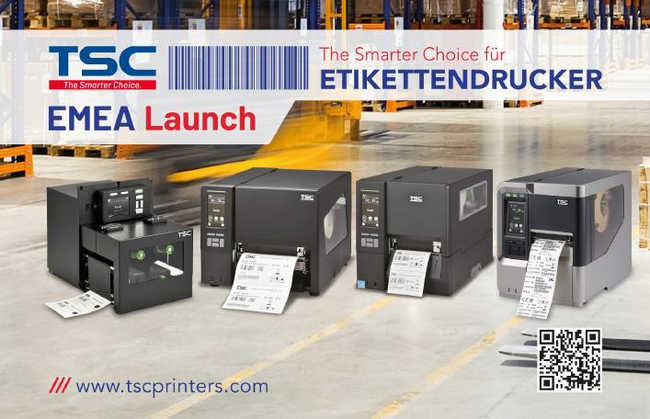
The upgraded printers are all supported by SOTI Connect, which gives greater visibility and real-time data on the health and performance of an entire fleet of printers allowing them to be managed remotely.
Vast improvements in printhead management help prevent incorrect or poor quality labels entering the supply chain. The printhead mechanisms checks and reports bad dots on the printhead in real-time. Users get alerted in advance to replace faulty printheads thereby avoiding production downtime. The new printheads incorporate a feature enabling printhead usage to be stored in the printhead mechanism giving users a clear indication of output levels as well as the printhead’s health and replacement status.
„We’re committed to delivering the most advanced thermal print technology to customers across demanding industrial environments like logistics, manufacturing and retail,“ says Sabine Mayer, Senior Marketing Manager of TSC Printronix Auto ID EMEA. „Our radical new line-up of rugged printer models are competitively priced yet bring unprecedented performance and precision to users.“
Further information on the upgraded devices can be found at:
www.tscprinters.com
www.printronixautoid.com
TSC Auto ID Technology EMEA GmbH
TSC and Printronix Auto ID are proud members of the TSC Auto ID Technology Company family. In the EMEA region, TSC is represented by its subsidiary TSC Auto ID Technology EMEA GmbH in Zorneding (Munich). The GmbH is responsible for sales, support and marketing of both brands TSC and Printronix Auto ID in the regions of Europe, Middle East and Africa. Managing Directors are Amine Soubai and Ladislav Sloup. TSC sells its products exclusively through distributors and value-added resellers (VAR).
Flexitron Group, the Spanish group dedicated to IoT markets acquires majority stake in Webdyn SA to extend its footprint in the energy transition market.
Flexitron Group is a Spanish conglomerate focusing on IoT sectors. The group has its headquarters in Madrid with employees worldwide with offices in Europe, Africa, Latin America, USA and Asia. Some of its major companies include Matrix (with the brand MTX) for IoT hardware solutions, IoTBlue for IoT software and Taxitronic, the global leader in taxi management solutions. MTX devices are part of all kinds of IoT solutions wordlwide, with active projects in sectors such as Smart Transportation, Smart City, Metering or Industry 4.0. Taxitronic has more than 150,000 active taximeters on the market and more than 30,000 data terminals connected to a radio taxi with Taxitronic technology, with a presence in the main countries of Western Europe, North America (especially New York), the Middle East and North Africa. The group is privately owned and led by José María Vilallonga Presas & José Luis Vicente Garcia.
Webdyn, founded by Philippe Faugeras in 2000 has been a pioneer in the development of IOT solutions with a unique portfolio and footprint in Smart Metering and Energy Control markets. Webdyn is particularly well-known for its WebdynSun Product portfolio, which enables photovoltaic developers and operators to manage their solar farms more efficiently and its WebdynEasy product range for smart building applications. Webdyn’s products are sold worldwide, and particularly in Europe and India where Webdyn has a subsidiary. The company has been backed by Kreaxi and Trophy Investissement who are successfully selling their shares to Flexitron.

For José María Vilallonga Presas, chairman of the Flexitron group, Webdyn is a nice fit in the Flexitron group family: “Webdyn has a unique product portfolio: customers love their products and appreciate their functionalities and quality. Our team saw the market potential of Webdyn’s portfolio and how we can extend Webdyn’s reach with our market access. In addition, we believe that Flexitron’s group and Webdyn’s people share common values of trust, ethics, and professionalism. We are very excited to welcome Webdyn into the Flexitron group.”
Philippe Faugeras is very pleased with the acquisition by Flexitron: “ As a founder, I was looking for an acquirer who would help us continue to grow Webdyn with a similar entrepreneurial spirit. First, we identified strong products and market synergies between the two entities. Second, we liked Flexitron's team. We share a common vision in terms of on our goal to contribute to energy transition and believe our teams can work well together to leverage those synergies. We are very happy to be joining forces.”
Philippe Méré, Partner at Kreaxi, an early investor in Webdyn added: “ We thank Philippe and the whole Webdyn team for their dedication and passion over the years. The IOT market took time to ramp up. Webdyn never gave up and found the right spot to focus on. Webdyn now has a unique product position and a strong team. We are happy to have the backing of an entrepreneurial group with strong market knowledge looking to expand Webdyn’s presence globally”.
For Emmanuel Simmonneau, CEO of Sigma Gestion, representative of Trophy Investment: “ It has been a great journey working with Philippe and the Webdyn team. We wish them and Flexitron group lots of success in this new phase”.
For Eric Plantier, chairman of Webdyn’s supervisory board and financial advisor for the transaction: “ Those last years working with Philippe, the Webdyn team, Kreaxi and Trophy have been memorable for us. We welcome the Flexitron group onboard and are looking forward to working with them to continue expanding in the energy transition markets”.
Transaction main contributors:
Flexitron Group: José María Vilallonga Presas
Flexitron legal team: Advanced Avocat, Nacime Tobni
Flexitron audit team: Ecovis, Robert Yalap
Webdyn: Philippe Faugeras
Webdyn financial advisors: Blueprint Partners, Eric Plantier and Elaine Wen Yi
Webdyn legal advisors: Harlay Avocat, Marie Laure de Cordovez and Lakhdar Saïfi
About FLEXITRON GROUP
Matrix Electronica SL that later became Flexitron was founded 30 years ago as a distributor of electronic components for the professional market. Since then, the group has expanded both organically and through acquisitions employing 250 people today (post Webdyn’s acquisition). Flexitron focuses on industrial IOT solutions sold throughout the world incl. USA, Europe, Israel, Middle East and Asia. The group’s values are to keep satisfied customers served by motivated employees with excellent products developed by our R&D Teams.
About WEBDYN
Webdyn is a specialist in industrial IOT solutions with a unique footprint in energy and environment markets. Webdyn core products are concentrators, gateways, end points and sensors for Smart Grids, Smart Building & Photovoltaic segments. Webdyn has unique expertise in cellular, Lora, Wireless-Mbus, RF and PLC technologies. Webdyn has 30 employees based in Saint Germain outside Paris and in New Dehli, India.
New research reveals institutional investors predict an increase in industrial activity will drive precious metal prices higher
New research (1) with institutional investors and wealth managers reveals a positive outlook for global industrial activity in 2021, and this should have a positive impact on demand for precious metals and their valuations.
- Adoption of green technologies and combating climate change are key factors in demand for precious metals
The study, from Global Palladium Fund (GPF), which has recently listed four physically-backed metal Exchange Traded Commodities (ETCs) - including ones that track the spot price of palladium and platinum - shows that two thirds of investors (67%) predict industrial activity will increase this year. This will drive the price of metals such as silver, palladium and platinum higher according to 69% of professional investors surveyed. Almost a quarter (24%) predict that prices will increase dramatically.
Palladium
 Palladium is a vital component of catalytic converters which turn the most harmful pollutants in car exhaust gas into environmentally friendly compounds like carbon dioxide and water. It also has a range of other applications, including ceramic capacitors, which regulate the flow of electricity in smartphones and laptops.
Palladium is a vital component of catalytic converters which turn the most harmful pollutants in car exhaust gas into environmentally friendly compounds like carbon dioxide and water. It also has a range of other applications, including ceramic capacitors, which regulate the flow of electricity in smartphones and laptops.
When considering the key factors influencing the price of palladium, 90% of investors said that growing electric car sales in China will play an important role in pushing the metal’s valuation higher, 89% cited the weak US dollar as a driver of appreciation, and over three quarters (77%) said that continuing shortages of the metal would mean the price continues to rise.
Over two thirds (67%) of investors said that tighter emission standards would also push the price higher. For example, in 2019, China introduced new vehicle emission standards ('China VI'), which are among the strictest in the world. To comply, all new cars sold in China will have to be equipped with good-quality catalytic converters, and that means as much as 30% more palladium per vehicle.
Platinum
The study also highlights platinum’s importance in the future hydrogen economy thanks to its unique hydrogen-absorbing properties, and as an essential metal for cleaning toxins from the environment. Given this, plus the United States re-joining the Paris climate accords under President Biden and the growing focus on combating climate change, the majority (95%) of investors agree that industrial demand for Platinum should increase over the coming months and years, and 85% predict that the price of platinum will rise in 2021.
Also, Platinum remains at a very inexpensive level compared to palladium and rhodium. The potential to substitute these metals for platinum could lead to growth in value of the metal – a view that 90% of professional investors interviewed agree with.
Alexander Stoyanov, Chief Executive Officer of GPF said: “Our research shows just how important precious metals are to making the green economy a reality. Their properties mean that they have a fundamental role to play in technologies such as hydrogen fuel cells and other green technologies crucial to changing the world we live in and, as a result, demand for metals such as palladium and platinum will increase.”
NTree International Ltd, a specialist in marketing, distribution and investor engagement, is leading the distribution and rollout of the products. NTree has set up a dedicated brand, Metal.Digital https://metal.digital as an education resource for professional investors with a focus on metals.
Timothy Harvey, Chief Executive Officer and Founder of NTree, said: “Investing in precious and industrial metals has never been timelier as global economies seek to address climate change. That’s why we have launched new metal ETCs that have the lowest charges in the marketplace, enabling investors to access metals cost effectively.”
Global Palladium Fund’s (GPF) new ETCs are listed on the Deutsche Börse and London Stock Exchange and have the lowest charges with total expense ratios (TER) ranging from 0.145% to 0.20%. Targeting Family Offices, wealth managers, institutional and other professional investors, the new physically-backed gold, silver, platinum and palladium ETCs track the spot price of the respective metals they cover.
The ETCs have a strong focus on ESG. LBMA-approved metal will be sourced from producers and suppliers who support the Sustainable Development Goals of the UN 2030 Agenda and other global initiatives in sustainable development and responsible mining.
GPF is also the first to use Blockchain technology to record bar information into Distributed Ledger Technology, thereby providing an extra layer of security and proof of ownership to the Issuer. The use of Blockchain is in addition to the traditional recording processes used by the custodian.
(1) Global Palladium Fund commissioned the market research company Pureprofile to interview 100 professional investors – 50 institutional investors and 50 wealth managers – across the UK and Germany. The survey was conducted online in January 2021.
Sustainably sourced
Good Delivery Rules’ set by LBMA, LPPM, and LME for precious and base metals are universally acknowledged as the de facto international standard for due to the strict criteria that apply to responsible mining operations and protection of human rights.
LBMA established the Responsible Gold Guidance for Good Delivery Refiners that follows the five-step framework due diligence of the OECD Due Diligence Guidance for Responsible Supply Chains of Minerals.
Global Palladium Fund
The Global Palladium Fund, set up by Norilsk Nickel in 2016, strives to advance the development of world-changing technologies in essential areas such as aerospace, electronics, and the automotive industries to help make the world a better place. In an industry first, GPF is enabling industrial consumers and investors access to a range of metals in a variety of formats, including the ETCs. GPF is proud to be supported by Norilsk Nickel. Its products are in high demand across the globe and it has operations in the Russian Far North, Finland and South Africa.
For more information, visit: www.gpf.global
Norilsk Nickel
Norilsk Nickel is the world’s largest producer of palladium, high-grade nickel and a major producer of platinum, copper, precious metals and rare earths.
NTree
NTree provides professional investors with an education and distribution service to access commodities and China through active and passive fund solutions including Exchange Traded Products. It will promote the GPF ETCs, providing investor education and insights into the role and importance of the metals as well as their place in portfolios (please visit www.ntree.co.uk for more details)
